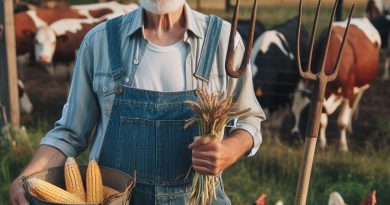Sustainable Farming: Agroforestry in Action
Last Updated on March 2, 2024
Introduction
Sustainable farming refers to a farming method that aims to preserve the environment while meeting the needs of present and future generations.
Agroforestry is an essential component of sustainable farming as it integrates trees with crops or livestock, providing numerous benefits.
Agroforestry is vital in sustainable farming because it helps improve soil fertility, prevents erosion, and enhances biodiversity.
Additionally, agroforestry systems reduce the need for synthetic fertilizers and pesticides, leading to healthier ecosystems and reduced water pollution.
Agroforestry can also generate additional income for farmers through the sale of timber, fruits, nuts, or medicinal plants.
The shade provided by trees in agroforestry systems helps regulate temperature and conserve water, creating a microclimate suitable for crop growth.
Agroforestry systems also contribute to climate change mitigation by sequestering carbon dioxide from the atmosphere and reducing greenhouse gas emissions.
These systems promote sustainable land use practices, maintain soil health, and contribute to global food security.
In short, agroforestry plays a significant role in sustainable farming by providing a myriad of benefits, including improved soil fertility, enhanced biodiversity, reduced water pollution, and additional income for farmers.
Embracing agroforestry is crucial for a sustainable future, as it promotes the harmonious coexistence of agriculture and trees.
Explanation of Agroforestry
Agroforestry is a sustainable farming practice that combines trees and crops to create a diversified and resilient ecosystem.
It involves intentionally integrating trees into agricultural systems for multiple benefits.
Definition and concept of agroforestry
Agroforestry is the integration of trees and agriculture, where farmers simultaneously manage both for maximum productivity.
It is a land management approach that combines the benefits of agriculture and forestry to create sustainable and productive systems.
Unlike conventional farming, which focuses solely on crop production, agroforestry recognizes the importance of trees in enhancing soil health, conserving water, and providing various ecosystem services.
History and origins of agroforestry
Agroforestry is not a new concept and has been practiced for thousands of years.
Indigenous communities around the world have been using agroforestry techniques to sustainably manage their lands and resources.
Many ancient civilizations, such as the Mayans and the Incas, practiced agroforestry to cultivate crops in harmony with their surrounding forests.
These traditional knowledge and practices have been passed down through generations, forming the foundation for modern agroforestry systems.
Types of agroforestry systems
There are several types of agroforestry systems, each with its unique characteristics and benefits.
Here are four commonly practiced ones:
Alley cropping
Alley cropping involves growing crops in between rows of trees or shrubs. The trees provide shade, windbreak, and leaf litter that enriches the soil.
This system helps reduce erosion, increase water infiltration, and improve nutrient cycling.
Forest farming
Forest farming, also known as agroforestry in forested areas, involves cultivating crops under a forest canopy.
This system mimics natural forest ecosystems and allows farmers to grow shade-tolerant crops, medicinal plants, and non-timber forest products.
It promotes biodiversity conservation and provides economic opportunities.
Silvopasture
Silvopasture combines trees, forage crops, and livestock grazing in a single integrated system.
Trees provide shade for animals, contribute to soil fertility, and offer timber or non-timber forest products.
This system improves animal welfare, increases forage production, and reduces greenhouse gas emissions.
Windbreaks and shelterbelts
Windbreaks or shelterbelts are rows of trees planted to protect croplands or livestock from wind and soil erosion.
They act as barriers, reducing wind speed, and creating microclimates that enhance crop growth.
Windbreaks also provide habitat for beneficial insects and birds, promoting natural pest control.
Agroforestry offers a sustainable alternative to conventional agriculture, addressing various environmental and social challenges.
It reduces the reliance on synthetic inputs, enhances biodiversity, mitigates climate change, and improves the resilience of farming systems.
Moreover, agroforestry provides additional income streams for farmers through diversified products.
In fact, agroforestry is a holistic approach to farming that integrates trees and agriculture to create sustainable and productive systems.
It is rooted in traditional knowledge and practices and offers various benefits for both farmers and the environment.
By adopting agroforestry, we can move towards a more sustainable and resilient agricultural future.
Read: Eco-Farming: Merging Trees with Crops Effectively
Benefits of Agroforestry
Agroforestry is a sustainable farming practice that integrates trees with crops and/or livestock on the same plot of land.
Beyond its ability to generate multiple products, agroforestry provides numerous environmental, economic, and social benefits.
Environmental benefits
Agroforestry plays a crucial role in conserving biodiversity by creating habitats for a wide range of plant and animal species.
The combination of trees and crops also helps in soil conservation by reducing erosion caused by wind and water.
Moreover, the presence of trees in agroforestry systems enhances water conservation by decreasing runoff and retaining soil moisture.
Additionally, agroforestry contributes to carbon sequestration, as trees absorb and store carbon dioxide, mitigating climate change.
Economic benefits
Agroforestry enables farmers to diversify their income sources by cultivating different crops alongside trees.
This reduces their reliance on a single crop, making them more resilient to market fluctuations and potential losses.
Furthermore, by integrating trees into their farming systems, farmers can minimize input costs such as fertilizers and pesticides.
The trees’ ability to fix atmospheric nitrogen and enhance nutrient recycling improves soil fertility, leading to increased crop productivity.
Additionally, agroforestry’s protective canopy provides shade and windbreaks, resulting in higher crop yields and better crop quality.
Social benefits
The aesthetic appeal of agroforestry landscapes enhances the overall appearance of farming areas, contributing to the well-being of both farmers and communities.
Agroforestry also fosters community engagement and education, as farmers and local communities actively participate in planning and implementing agroforestry practices.
By working together, they can improve their understanding of sustainable agricultural techniques and empower themselves economically.
Importantly, agroforestry enhances food security by diversifying diets and providing a sustainable source of nutrient-rich foods.
This helps to ensure that communities have access to a variety of food sources, reducing the risk of malnutrition.
In essence, agroforestry offers numerous benefits across different aspects of sustainability.
Not only does it protect the environment through biodiversity conservation, soil and water conservation, and carbon sequestration, but it also provides economic stability by diversifying income sources, reducing input costs, improving soil fertility, and increasing crop yields.
Moreover, agroforestry promotes social well-being through enhanced landscape aesthetics, community engagement and education, and improved food security.
By implementing agroforestry practices, farmers can achieve a sustainable and resilient farming system that balances the needs of people and the planet.
Read: Agroforestry 101: Basics for Sustainable Land Use
Successful Examples of Agroforestry in Sustainable Farming
Agroforestry has proven to be a successful approach to sustainable farming in various case studies. Let’s take a closer look at some of these examples:
Case study 1: Walnut Creek Watershed, Iowa
The farmers in the Walnut Creek Watershed in Iowa have implemented a range of agroforestry practices on their farms.
These practices include intercropping, alley cropping, and windbreaks.
Through intercropping, farmers plant trees or shrubs among their crops. This technique provides numerous benefits.
The trees help reduce soil erosion, as their root systems bind the soil together, preventing it from washing away during heavy rains.
Additionally, they provide shade for the crops, which helps control the temperature and reduce water evaporation.
This leads to increased water efficiency and ultimately higher crop yields.
Alley cropping, another agroforestry practice implemented in the Walnut Creek Watershed, involves growing crops in alleys between tree rows.
This not only provides additional space for crop production but also facilitates pest control.
The trees act as a barrier, reducing the spread of pests and diseases from one crop to another.
Moreover, they offer habitat for beneficial insects that prey on harmful pests.
Windbreaks, consisting of strategically planted trees or shrubs, are another agroforestry practice used in the watershed.
These windbreaks serve as natural barriers against strong wind gusts, protecting the crops from wind damage.
They also reduce water evaporation caused by wind and prevent the loss of fertile topsoil due to erosion.
Case study 2: The Center for Agroforestry, Missouri
The Center for Agroforestry in Missouri actively promotes and implements agroforestry practices among farmers in the region.
One of the key practices they emphasize is silvopasture.
Silvopasture combines trees, forage crops, and livestock on the same piece of land. This integration brings several benefits.
The trees provide shade for the livestock, creating a more comfortable environment and reducing heat stress.
Additionally, the forage crops, such as grasses and legumes, provide nutritious feed for the animals.
The combination of trees and forage crops also improves soil health by increasing organic matter content and nutrient cycling.
According to farmers who have embraced agroforestry, these practices have resulted in increased profitability and resilience.
The integration of trees with conventional agricultural practices has diversified their income streams through the sale of timber and non-timber forest products.
Furthermore, agroforestry systems have proven to be more resilient to extreme weather events, as the trees provide a buffer against climate-related challenges.
Case study 3: Forest Agriculture Nursery
The Forest Agriculture Nursery serves as a key example of successful agroforestry practices.
They specialize in growing fruit and nut trees using agroforestry techniques.
One of their primary practices is alley cropping, where they grow fruit and nut trees in alleyways between vegetable crops.
This integration allows for efficient land use and maximizes productivity.
The trees provide shade and act as windbreaks, protecting the vegetables from harsh weather conditions.
Additionally, the trees produce fruits and nuts, diversifying the farm’s products and income sources.
The Forest Agriculture Nursery has experienced numerous benefits from agroforestry.
They have reported increased biodiversity on their farm, as the diverse plantings attract a range of beneficial organisms.
The trees also contribute to improved soil health by enhancing soil structure and organic matter content.
Moreover, the presence of fruit and nut trees provides an additional market opportunity, boosting the farm’s economic sustainability.
In general, these case studies highlight the successful implementation of agroforestry practices in sustainable farming.
The Walnut Creek Watershed in Iowa, the Center for Agroforestry in Missouri, and the Forest Agriculture Nursery all demonstrate how agroforestry can enhance environmental sustainability, improve farm resilience, and diversify income sources.
These examples serve as inspiration and motivation for farmers to adopt agroforestry techniques in their own operations.
Read: The Economics of IPM in Agriculture

Find Out More: Polyculture Farming: Diversity in Action
Challenges and Limitations of Agroforestry
Lack of awareness and knowledge
- Many farmers are unaware of the benefits and techniques of agroforestry.
- Insufficient knowledge on suitable tree species, their management, and integration with crops.
- Training programs and educational campaigns are required to address this challenge.
- Collaboration between agricultural institutions and farmers can help exchange knowledge and best practices.
Land constraints and management issues
- Availability of adequate land for agroforestry may be limited, especially in densely populated regions.
- Land ownership issues, land degradation, and competing land uses pose challenges.
- Effective land management strategies and proper land-use planning are vital.
- Integration of agroforestry in existing agricultural systems can optimize land utilization.
Financial barriers and investment requirements
- Establishing an agroforestry system requires initial investment for land preparation, tree planting, and maintenance.
- Small-scale farmers may lack the necessary capital or access to affordable credit facilities.
- Government support, subsidies, and microfinance initiatives can help overcome financial barriers.
- Developing sustainable financing models and business plans can attract investors.
Market access and demand
- Agroforestry products may face limited market access due to inadequate value chains and infrastructure.
- Consumer awareness and demand for sustainable agricultural products need to be strengthened.
- Efforts should be made to promote agroforestry products through marketing campaigns and certifications.
- Establishing direct links between farmers and consumers can enhance market opportunities.
Government policies and regulations
- Existing policies and regulations may not be supportive or inclusive of agroforestry practices.
- Lack of coordination between different government departments can hinder agroforestry development.
- Advocacy for policy reforms and the integration of agroforestry in national agricultural frameworks is crucial.
- Establishment of clear guidelines, incentives, and implementation mechanisms can facilitate agroforestry adoption.
Addressing these challenges and limitations of agroforestry will require a collaborative effort from farmers, governments, NGOs, and research institutions.
By raising awareness, providing technical support, and implementing supportive policies, the potential of agroforestry can be fully harnessed, leading to sustainable farming practices and improved livelihoods.
Read: IPM Training: Empowering Sustainable Farmers
Steps to Promote Agroforestry Adoption
Education and awareness programs
- Conduct workshops and training sessions to educate farmers about the benefits of agroforestry.
- Raise awareness among farmers and local communities through seminars, field demonstrations, and educational campaigns.
- Provide resources such as informative brochures, videos, and websites to disseminate knowledge about agroforestry practices.
- Collaborate with agricultural extension services to ensure farmers have access to up-to-date information on agroforestry techniques.
Financial incentives and assistance
- Offer financial support in the form of grants, subsidies, and low-interest loans to encourage farmers to adopt agroforestry practices.
- Develop programs that provide financial incentives for farmers who implement agroforestry systems on their land.
- Establish partnerships with financial institutions to provide specialized financing options for agroforestry projects.
- Create tax credits or deductions for farmers engaged in agroforestry, incentivizing adoption and investment in sustainable farming practices.
Policy and regulatory support
- Develop and enforce policies that promote and encourage the adoption of agroforestry practices.
- Advocate for government initiatives and support programs specifically aimed at agroforestry development and implementation.
- Work with local and national governments to ensure that agroforestry practices are integrated into agricultural policies and regulations.
- Conduct research to generate evidence-based policy recommendations for the advancement of agroforestry.
Research and development efforts
- Invest in research to develop innovative agroforestry techniques, improved crop varieties, and sustainable farming methods.
- Foster collaborations between research institutions, farmers, and industry stakeholders to address agroforestry-related challenges.
- Support field trials and experiments to evaluate the viability and effectiveness of different agroforestry models.
- Continuously assess and refine agroforestry practices through ongoing research and development efforts.
Collaboration and networking
- Foster collaboration and knowledge-sharing among farmers, researchers, NGOs, and government agencies interested in agroforestry.
- Organize conferences, workshops, and platforms for stakeholders to exchange best practices and lessons learned.
- Establish networks and forums to facilitate the flow of information, resources, and experiences related to agroforestry.
- Encourage the creation of farmer associations and cooperatives to promote collective action and mutual support in agroforestry adoption.
By implementing these steps, we can drive the widespread adoption of agroforestry, promoting sustainable farming practices and contributing to a more resilient and environmentally friendly agricultural sector.
Conclusion
Agroforestry offers numerous benefits for farmers and the environment. It enhances soil fertility, reduces erosion, and improves water quality.
By combining trees with crops or livestock, agroforestry diversifies income streams, providing economic stability for farmers.
Additionally, agroforestry promotes biodiversity by creating habitats for wildlife and supporting pollinators, contributing to ecosystem resilience.
If you are a farmer seeking sustainable farming practices, agroforestry is a solution worth considering.
It offers multiple benefits, including improved soil health, increased income opportunities, and environmental conservation.
Agroforestry allows you to foster a more resilient farming system that can adapt to climate change and economic fluctuations.
The future of agroforestry looks promising as more farmers recognize its potential to address key challenges in agriculture.
With increased awareness and support, agroforestry can play a vital role in building sustainable food systems and combating climate change.
Through collaboration between researchers, policymakers, and farmers, agroforestry can be expanded and integrated into mainstream agricultural practices.
By embracing agroforestry as a powerful tool, we can create a more sustainable and resilient future for farming.


